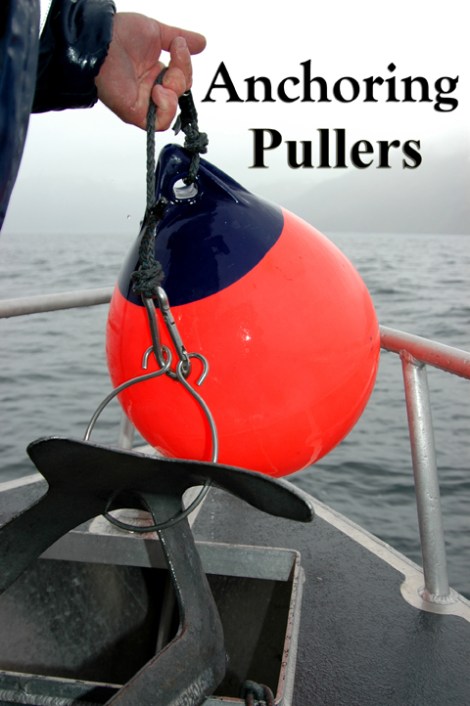Anchoring for halibut is easy if you know how and follow some basic safety rules and advice. First off, don’t anchor during rough water conditions. This could mean strong opposing winds and currents or rough seas. During these conditions you MUST use more scope and be extremely watchful of weather, tides, currents and how your boat handles the rough water while on anchor. With that said, during “standard” fair weather days, when seas don’t exceed two to three feet, the following tips should help you anchor successfully while fishing for halibut or any other species. When in Alaska at Whaler’s Cove Lodge I will anchor for halibut, rockfish, black cod and salmon.
Tip: You MUST have enough chain to equal your boat’s length. However, 1 ½ times to 2 times the length works best.
Anchor Line (Rode) Scope Rule of Thumb:
You need a minimum of 1/3 more line than depth. For instance, to anchor in 300-feet of depth you will need at least 400-feet of line, depending on winds & currents. Remember, safety first. If your anchor drags bottom, play out more line to increase the scope. You can also use your trolling motor to move your boat side to side and too reposition if wind or current moves you off your hotspot. Additionally, if current or wind shift your boats position try cleating your anchor line to either the port or starboard bow cleat. This will swing you in the opposite direction of your cleated anchor line.
If the bite dies off, before moving play out 50 feet of anchor line and give it an additional 30 to 60 minutes fishing time. This technique has produced dozens of halibut for me. This technique puts your baits and lures down current, and into range of halibut moving into your scent field.
 If you don’t have a windlass (electric or hydraulic anchor puller on bow) on your boat, a simple anchor puller will work just fine to safely pull your anchor. There’s several devices available on the market including EZ Marine Anchor Puller and several other brands that attach to your anchor line. These devices allow you to stop pulling and pinch the line preventing the anchor from falling back to the bottom.
If you don’t have a windlass (electric or hydraulic anchor puller on bow) on your boat, a simple anchor puller will work just fine to safely pull your anchor. There’s several devices available on the market including EZ Marine Anchor Puller and several other brands that attach to your anchor line. These devices allow you to stop pulling and pinch the line preventing the anchor from falling back to the bottom.
I prefer the ring style system because of the super small diameter Kevlar line I use. The high tensile strength, small diameter line slips through the pinch style pulling devices, which make the ring my only option. The ring shown to the left is an inexpensive device available at most marine supply stores for less than $20. You can also choose a solid stainless steel ring, but only if you visit a marine supply store such as LFS Marine that has commercial fishing supplies. The solid rings come in several sizes, but my top choice is a ring that spans 10 inches across. This size works well for me and should work for you as well.
Attach a big round buoy to the ring with strong rope and you have an anchor puller. When it comes time to pull anchor cleat the anchor line off to a starboard side cleat at midship. If you have a small boat, you can pull from the bow cleat, but keep a watchful eye on the anchor line. When ready to pull the anchor aim up current from the buoy and keep your anchor line to the starboard side of the boat. This gives you the best view of the anchor line while pulling. Go fast enough to maintain control while keeping in the anchor line away from the prop. The drag of the buoy allows the anchor line to pass through the anchor pulling device. Also watch other boats in the area and don’t drive to close to them while pulling anchor. This is a good reason why you should not anchor to close to other boats.
From Stern Anchoring Method
Instead of using your bow for anchor operations, you can attach a 1/2 line from your bow cleat or U bolt where you attach your boat to your trailer, and attach the other end to your stern cleat. Add a quick disconnect stainless steel clip on ends of the rope to enable you to disconnect your anchor quickly in case of emergency or chasing a big fish. Put a small stainless ring on this length of rope or simply use another stainless steel heavy duty clip on the end of your anchor line. This clip will enable the anchor line to slide from the stern to the bow. Note: You must use one large clip on the end of the rope from the bow. When pulling anchor the anchor line clip will slide over the knot and clip into the larger clip, providing a strong, safe pulling point for the anchor pulling device. Take note of how much anchor line you have, for instance, if you plan to anchor in 300 feet of water you should have 600 feet of line. When it comes time to anchor clip the end of the anchor line to the small ring, then deploy all of your line, making sure you have enough line to secure the anchor and chain to the bottom. Deploy your anchor line from the stern of the boat with the buoy and ring or anchor pulling device still aboard, but with the anchor line running through the big ring or device. After the line is deployed throw the anchor buoy over the side. The boat will drift back and push the anchor line to the bow.
When it comes time to pull anchor pull forward and to the left until the ring slides back to the cleat and pull away, watching to make sure you don’t run over the top of your line. When the anchor is on the surface circle to the right and gather up the anchor line from the stern.
Here’s an anchor pulling video to see how the system works. There’s also an anchor guide farther down the page.









